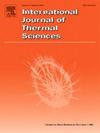棱柱形锂离子电池仿生蕨脉液体通道与相变材料相结合的热管理系统的热性能
IF 4.9
2区 工程技术
Q1 ENGINEERING, MECHANICAL
International Journal of Thermal Sciences
Pub Date : 2025-03-08
DOI:10.1016/j.ijthermalsci.2025.109844
引用次数: 0
摘要
本文章由计算机程序翻译,如有差异,请以英文原文为准。
Thermal performance of thermal management system combining bionic fern-vein liquid channel with phase change materials for prismatic Lithium-ion battery
Thermal management is crucial for prolonging the life and ensuring the safety of Lithium-ion battery. Two hybrid battery thermal management system (BTMS) are proposed, that paraffin-based phase change materials containing alkanes (PCM) are wrapped around bionic fern leaf vein channels or bionic fern leaf vein fins in cold plate. Then the thermal characteristic of cold plate, like non-bionic (NON-B), bionic fern-vein channel (BFC), and bionic fern-vein fin (BFF) were numerically investigated to evaluate the thermal performance of three distinct cold plates at different mass flow rates, fluid inlet temperatures, and ambient temperatures. The results indicated that the BFC (40.71 °C) cold plate reduced the maximum temperature more effectively than the BFF (41.26 °C) and NON-B (44.12 °C) plates, with maximum reductions of 7.7 % and 21.3 %, respectively. Additionally, compared to the BFF (21.6 Pa) and NON-B (33.1 Pa) plates, the BFC (14.2 Pa) cold plate achieved maximum reductions in pressure drop and pumping power by 57.1 % and 20.8 %, respectively. The heat transfer and flow resistance performance of the cold plates were evaluated using a dimensionless comprehensive thermal performance evaluation factor j/f. The j/f of BFC (5.82) increased by 390 % and 396 % compared to BFF (1.19) and NON-B (1.17), indicating that the BFC cold plate has the best comprehensive performance. The proposed BTMS can increase the contact area between PCM and cold plate through the integration of bionic fins, which improves the thermal performance.
求助全文
通过发布文献求助,成功后即可免费获取论文全文。
去求助
来源期刊

International Journal of Thermal Sciences
工程技术-工程:机械
CiteScore
8.10
自引率
11.10%
发文量
531
审稿时长
55 days
期刊介绍:
The International Journal of Thermal Sciences is a journal devoted to the publication of fundamental studies on the physics of transfer processes in general, with an emphasis on thermal aspects and also applied research on various processes, energy systems and the environment. Articles are published in English and French, and are subject to peer review.
The fundamental subjects considered within the scope of the journal are:
* Heat and relevant mass transfer at all scales (nano, micro and macro) and in all types of material (heterogeneous, composites, biological,...) and fluid flow
* Forced, natural or mixed convection in reactive or non-reactive media
* Single or multi–phase fluid flow with or without phase change
* Near–and far–field radiative heat transfer
* Combined modes of heat transfer in complex systems (for example, plasmas, biological, geological,...)
* Multiscale modelling
The applied research topics include:
* Heat exchangers, heat pipes, cooling processes
* Transport phenomena taking place in industrial processes (chemical, food and agricultural, metallurgical, space and aeronautical, automobile industries)
* Nano–and micro–technology for energy, space, biosystems and devices
* Heat transport analysis in advanced systems
* Impact of energy–related processes on environment, and emerging energy systems
The study of thermophysical properties of materials and fluids, thermal measurement techniques, inverse methods, and the developments of experimental methods are within the scope of the International Journal of Thermal Sciences which also covers the modelling, and numerical methods applied to thermal transfer.
 求助内容:
求助内容: 应助结果提醒方式:
应助结果提醒方式:


